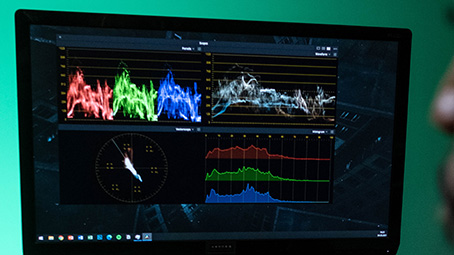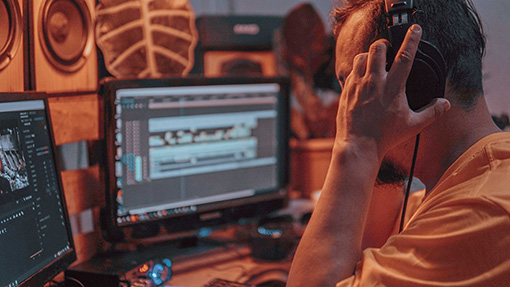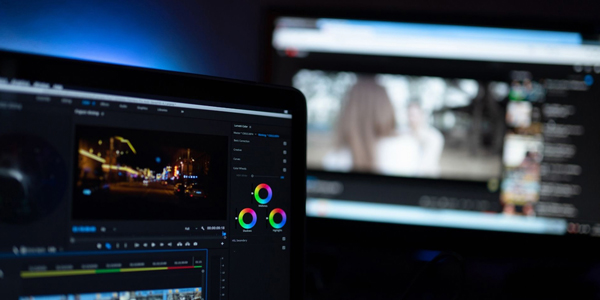The Importance of Post Production in Videos
Videos are an excellent means of promoting your business as they stand out more than a text or image based piece of content. A video with eye-catching vision and a polished audio mix can captivate an audience and replicate an in person interaction, giving your customers something that they will truly remember.
However for your video to really pop, it pays to know what post production- or editing – is and how to use it to transform your video footage into content that makes your brand shine.
So let’s explore the basics of post production and how it can be a powerful tool for your business to reach and retain customers.
What is post production?
Once your video has been conceived, written and filmed, the post production process starts.
During this stage of production, editors and motion graphic artists are hard at work editing your footage, mixing the audio and soundtrack, adding VoiceOver and creating effects to create a polished video that’s truly captivating.
Video post production is arguably one of the most crucial components of production, and using an experienced production company can turn your ideas and raw footage into results that engage and succeed.

The key differences between post production and production
The Production and post production are often grouped together, but they are two important and distinct components of the film making process. Production is the process in which the raw footage is recorded. Your crew, performers and equipment come to a location and your script is shot from every viewpoint and scenario envisaged duration ideation.
In contrast, post production occurs after the raw footage is shot and production is complete. The raw footage is then edited, and images, sound and visual effects are added to bring it to life.

What does the post production process look like?
Software and Hardware
Editing software enables you to import footage into a project, select best takes in a timeline, manipulate footage, add elements like music, text and graphics and export into a video ready to publish.
There are many options available for editors, both free and paid with software that works across different operating systems both on smartphones and computers.
The best choice for you will likely be determined by the device you wish to edit on as well as your budget and skill set. And whilst there are several options for editing on smartphones, if you’re looking to create more professional looking videos, then editing on a Mac or desktop offers a far superior user experience and strong range of options.
Even the most obvious difference between a phone and desktop / laptop – the size of the screen – will make for an easier analysis and manipulation of footage, but also enable you to use external media storage and second or third screens.
Go-to software
The majority of professional editors use Adobe’s Premier Pro which is available as a monthly or annual subscription-based software for both Mac and PCs. At the time of writing our business uses the Apple-only pay-for-once app Final Cut Pro (a pro version of Apple’s free iMovie offering) and many prefer the more costly Avid Media Composer, a PC and Mac-friendly system favoured by film and television editors.
All of these systems have different interfaces, naming conventions and shortcuts, and of course raving fans and sworn nay-sayers, but broadly they all offer the same functionality. I suggest you ask your circle of influence, social communities and consider your company situation (for instance if you have a design team your organisation may already subscribe to the Adobe suite of products)as a way to help decide.
If none of these appeal or are feasible from a cost perspective, there are a plethora of cheaper come-and-go and hear-to-stay software options available for the business user from Camtasia to Lightworks and many more.
Whichever option you choose, rest assured there are also many resources available to help master your software of choice. And of course there’s no substitute for learning as you go on a real-world project.

Media and storage
Video is a hungry beast – a minute of footage shot at 4K will gobble up 5 GB of storage, so establishing a reliable and secure storage system and process is key to seamless post production. Many an editor can recall the heartache and hours lost – or projects failed – due to misplaced or damaged footage and poor media management.
Rather than importing footage onto your computer or laptop, which will quickly affect the speed and performance of your system, invest instead in an external storage system.
Where possible go for the fastest and most robust devices for your operating system. In our case at the time of writing we use a RAID 5 storage system that allows for one of the disks to fail and be replaced without loosing data. This system has a series of cable ports with Thunderbolt 3 capability that also maximises the speed of media transfer between the hardware and our operating system.
For enhanced security we also back up all shot footage on an another external hard drive system (which we delete once the project has been completed and delivered) and have cloud-based storage system of final projects in case our building is destroyed.
If you have gone to the effort of paying – in time or in actual costs – of capturing footage for your business and there is a chance that it might be re-used in the future, consider also establishing a footage library. Vision of premises, events, products or even people can be re-proposed across other videos for many years to come and this way ensures that you don’t have to re-shoot.
Organising Assets
A video project is made up of many assets including shot footage, stock footage, stills, graphics and logos, music, voice over and sound effects.
Organising these elements in one place from the outset ensures if the project is transferred or duplicated across storage devices or shared between different editors, everything is self-contained, clearly identified and nothing will be lost.
This is because most professional editing software perform more efficiently when, rather than imprecating high volume files into a project, create a lower resolution or proxy version of those files that link directly to the original media. Changing this pathway or link by moving drives, folders and original media can in some instance result in accidentally deleted or lost media.
To avoid this happening collate everything about your project into one folder and on one drive ensuring everything is clearly labelled. Organise elements in such a way that if for someone reason you as editor vanished completely, a replacement editor can pick up the project and instantly understand and find all the elements and easily complete your project.
It also pays to adopt your naming convention when it comes to importing your media (or proxies)into your software, whether it be Premier Pro or Final Cut etc.
Tidy assets upfront make for a tidy and more efficient edit.

Preparing to edit
Depending on the complexity of your video, getting yourself organised from an editorial or narrative perspective before you start editing is important.
The level of organisation and preparation will be determined by who and how many people are working on post production. If for instance you conceived and shot the material yourself and will be doing the post production yourself, then you have an innate understanding of the project and what you are trying to achieve. A producer / director may hand over the project to a post production producer or often post production becomes the responsibility of a solo editor / predator (Producer / Editor).
Either way it’s good practice to review shot material, assets and refer back to the original project brief before a frame is edited. The more preparation you can do before commencing the physical editing, the more time and cost effective your project will be.
For any narrative recorded – interviews, pieces to camera, voice over or presentations – it pays to organise a transcript, a written document of the words recorded with time code. There is software available or you can easily outsource this for a fee. (At the time of writing we use Rev and Happy Scribe)
Review the footage shot and together with a written transcript, prepare a post production script detailing which audio, visual and textural elements will be used in your video and the sequence of these elements. Although a written transcript saves listening (or if you filed it all re-listening) to every second of a shot interview, it won’t tell you the intonations of someone’s delivery or if there are any sound glitches. What this means is that if you are combining parts of an interview into a single sentence, then you may have to re-visit that specific time ode to see if gluing two separate elements together will sound natural.
Preparing a post production script means you can theoretically hand over post production directly to an editor to follow your template – good fo editors that are less experienced for instance or when you are paying to outsource this element and time / cost is a factor.
Let the editing begin
Once a project’s assets are imported into editing software and a post production script has been prepared, the editing process can begin.
How you approach post production is largely down to the type of video project you are producing, but in most cases the most efficient process starts with assembling the narrative structure – presenter pieces to camera, interview answers and voice over – are laid down in a sequential order.
A skilled editor will select and assemble the best takes, seamlessly combining different elements into as natural a sounding timeline as possible. He or she will also allow the story to “breathe” by building in pauses to help with audience understanding, revising and fine tuning, re-ordering and editing as necessary until the narrative structure delivers the right meaning and story for an audience.
For some project this narrative timeline may need to be sighted, edited and approved before the colouring in begins and helps make the nest part of the editing process smoother.

The colouring In
Once narrative is locked in, an editor will start to add in the visual elements to the project timeline.
Using B roll footage – and often stock footage and still imagery, it’s about creating a series of shots seamlessly into sequences, using natural sound and recorded elements
In reality , it’s far more than just colouring in, rather a nuanced and skilled process that both enhances an audience’s understanding of and emotional connection with the story.
Editors will look closely at the raw footage and choose the best takes to include in the final sequence.
After the editors choose the best takes, the film is then cut to fit the script and storyboard in a way that focuses on the key messages that you want to get across to your audience.

Visual effects
Once your video is assembled, the editing team will add any effects (VFX), motion graphics, text animation and transitions between shots.
These are any elements that blend seamlessly into your business’s film (a professional company will ensure that the effects aren’t overly cheesy): anything from an animated company logo to something more extreme, like an explosion seen in a movie.
It’s all about making your video memorable and captivating and so is a crucial step in the post production process to get your viewers to remember your organisation.
Audio mixing
The soundtrack of a video is often taken for granted, but it can take your project to the next level. Background music must match the visual aspect of your film, it should reflect the tone, match the pacing, and aid in getting your central message across to your audience.
In fact, the music that’s included in your video dictates a majority of its tone. You don’t want to film a video about a children’s toy with a sad soundtrack because that works against the message you’re trying to promote. And that’s why sound designers customise soundtracks to match your video’s pace, changes in volume, and action tempo. In the final product, all the elements should blend together smoothly and not feel choppy and unorganised.

Voiceover recording
Voiceovers aren’t needed in every video project, but they can effectively clarify the essential points for your audience.
Your production team will assist you in finding a voiceover artist who fits the tone of your video and will successfully deliver your messages to your viewers.
Voiceover recordings often require several takes, which gives you the flexibility to match it to your project and make it feel more put-together.
Many voice over artists have home studios so can quickly and professional record voice tracks for your film.
Colour grading
This is an often overlooked component in the post production process but can make a world of difference in your finished product.
During this stage, an editor will go through your video and adjust the colour scheme to fit your intended mood and to create a sense of consistency. For example, if you want the mood or tone of your video to be exciting and upbeat, the editor may opt for a brighter palette.
Creating titles, credits, and graphics
Finally, sometimes you have to give credit where credit is due.
Many corporate videos that don’t need credits like product and social media promotions. However, if you do need credits, your production team will work with you to create something that includes all the team members that turned your idea into a reality. Experts will work to make these elements that mesh with the rest of your video.
Captions, transcripts and thumbnails
An important an often overlooked part of post production are the SEO assets that will help make your video be noticed by search engines and shown to the right people.
The advantage of getting your editors to do captions during editing (rather than automatically generated on platform) is that you can choose the font and colour of text to match your branding.
Putting an audio file and text transcripts can be uploaded onto platforms for search engine bots to read.
And the importance of a good thumbnail – possibly with elements from your completed video – help your video be noticed and watched.

Why is post production essential when creating a video?
Without the editing or post production process, there is no finished product, you simply have footage that may or may not tell the story you want to tell.
This footage – also known as rushes – is often raw and unpolished, shot out of narrative order and a collection of takes and elements that is unlikely to make sense, let alone tell a compelling story nor communicate the message that you’re looking to portray to your audience.
As a result, showing a video that hasn’t undergone the post production process is unlikely to make sense, let alone engage your viewers.
Every element of post production works together to create a cohesive film or video. This process adds a dash of movie magic that leaves your audience entertained and compelled by your video, which would otherwise be bland and confusing without it.
As a business, it allows you to create a video that will leave an impression on your customers, making them more likely to engage with your company.
Itchy Feet Digital is a collective of video producers, videographers and editors whose purpose is to deliver an awesome level of creativity, production efficiency and customer service to our clients.
And get in touch if you want to know about our post production services and how we can make your footage shine!

